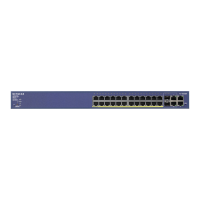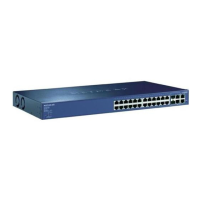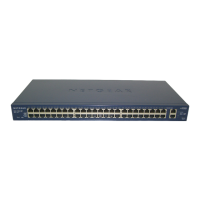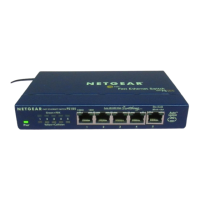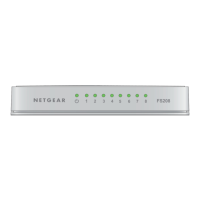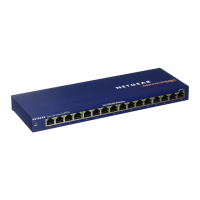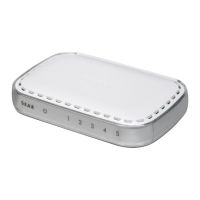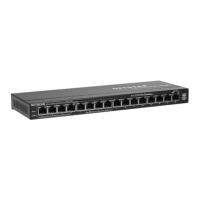Do you have a question about the NETGEAR FS728TP and is the answer not in the manual?
Identifies the target audience for this manual, focusing on system administrators.
Explains how to navigate and understand the manual's structure and content.
Details typographical conventions, message formats, and the manual's scope.
Provides instructions for printing the manual from PDF files.
Outlines the necessary hardware and software facilities for switch management.
Introduces the web server and SmartWizard Discovery utility for managing the switch.
Details the procedure for installing the switch in a DHCP-enabled network.
Explains how to set up the switch in a network lacking a DHCP server.
Describes methods for accessing the switch's web interface for management.
Highlights extra functions like password change and firmware upgrades.
Details the procedure for upgrading the switch's firmware.
Guides users on how to access and log into the switch's web interface.
Describes the main and left navigation areas of the web interface.
Explains the different options available within the web management system.
Demonstrates how to select specific entries within configuration tables.
Details the process of creating new entries in configuration tables.
Explains how to edit existing entries within configuration tables.
Describes how to remove entries from configuration tables.
Introduces GUI elements like Gold Buttons and Quick Boxes for configuration.
Covers general device information, IP, and time configuration settings.
Details how to configure system name, location, contact, and other device information.
Explains how to configure static or DHCP IP addresses for the switch.
Covers local system time and SNTP server configuration.
Displays a graphical representation of the device and its port/LED statuses.
Explains Power-over-Ethernet capabilities and applications.
Introduces Simple Network Management Protocol versions and features.
Introduces Link Layer Discovery Protocol for network topology.
Shows information received from neighboring devices via LLDP advertisements.
Covers configuration of individual switch ports.
Details settings for port speed, duplex mode, and status.
Introduces Link Aggregated Groups for increased bandwidth and redundancy.
Explains Virtual LANs for network segmentation and traffic management.
Describes creating and configuring VLAN IDs and names.
Introduces Spanning Tree Protocol for loop prevention.
Covers Rapid Spanning Tree Protocol settings for faster convergence.
Explains multicast forwarding and its types.
Describes the MAC address table and its sorting options.
Introduces Class of Service for implementing QoS and priority queuing.
Explains enabling QoS globally and selecting basic or advanced mode.
Covers defining QoS queue forwarding types and scheduling methods.
Explains defining ingress rate limits and egress shaping rates.
Details mapping CoS priority values to traffic queues.
Covers security settings for device management access.
Covers Remote Authorization Dial-In User Service server configuration for authentication.
Explains Terminal Access Controller Access Control System for centralized security.
Covers network authentication parameters for ports.
Details configuring network authentication using 802.1x standards.
Covers managing network traffic through Storm Control and Port Security.
Explains limiting port access based on MAC addresses.
Introduces Access Control Lists for defining traffic rules.
Covers defining MAC-based Access Control Lists.
Covers defining IPv4-based Access Control Lists.
Explains event message formats, severity levels, and log management.
Details enabling or disabling global logging for the device.
Explains viewing and configuring remote log servers and severity levels.
Introduces Remote Monitoring Statistics for viewing network traffic.
Covers viewing device utilization and error information.
Covers setting network alarms based on rising and falling thresholds.
Explains mirroring network traffic by forwarding copies of packets.
Covers device reboot and factory default reset options.
Explains resetting the device to its original factory settings.
Details backing up system files like firmware and configuration.
Covers downloading system files such as firmware, boot file, or configuration.
Manages active images and firmware/boot files for the device.
Provides tools and procedures for diagnosing and resolving issues.
Guides on testing copper cables attached to ports for errors.
Provides access to NETGEAR's online support resources and website.
Explains how to access the complete online user guide in PDF format.
Identifies the target audience for this manual, focusing on system administrators.
Explains how to navigate and understand the manual's structure and content.
Details typographical conventions, message formats, and the manual's scope.
Provides instructions for printing the manual from PDF files.
Outlines the necessary hardware and software facilities for switch management.
Introduces the web server and SmartWizard Discovery utility for managing the switch.
Details the procedure for installing the switch in a DHCP-enabled network.
Explains how to set up the switch in a network lacking a DHCP server.
Describes methods for accessing the switch's web interface for management.
Highlights extra functions like password change and firmware upgrades.
Details the procedure for upgrading the switch's firmware.
Guides users on how to access and log into the switch's web interface.
Describes the main and left navigation areas of the web interface.
Explains the different options available within the web management system.
Demonstrates how to select specific entries within configuration tables.
Details the process of creating new entries in configuration tables.
Explains how to edit existing entries within configuration tables.
Describes how to remove entries from configuration tables.
Introduces GUI elements like Gold Buttons and Quick Boxes for configuration.
Covers general device information, IP, and time configuration settings.
Details how to configure system name, location, contact, and other device information.
Explains how to configure static or DHCP IP addresses for the switch.
Covers local system time and SNTP server configuration.
Displays a graphical representation of the device and its port/LED statuses.
Explains Power-over-Ethernet capabilities and applications.
Introduces Simple Network Management Protocol versions and features.
Introduces Link Layer Discovery Protocol for network topology.
Shows information received from neighboring devices via LLDP advertisements.
Covers configuration of individual switch ports.
Details settings for port speed, duplex mode, and status.
Introduces Link Aggregated Groups for increased bandwidth and redundancy.
Explains Virtual LANs for network segmentation and traffic management.
Describes creating and configuring VLAN IDs and names.
Introduces Spanning Tree Protocol for loop prevention.
Covers Rapid Spanning Tree Protocol settings for faster convergence.
Explains multicast forwarding and its types.
Describes the MAC address table and its sorting options.
Introduces Class of Service for implementing QoS and priority queuing.
Explains enabling QoS globally and selecting basic or advanced mode.
Covers defining QoS queue forwarding types and scheduling methods.
Explains defining ingress rate limits and egress shaping rates.
Details mapping CoS priority values to traffic queues.
Covers security settings for device management access.
Covers Remote Authorization Dial-In User Service server configuration for authentication.
Explains Terminal Access Controller Access Control System for centralized security.
Covers network authentication parameters for ports.
Details configuring network authentication using 802.1x standards.
Covers managing network traffic through Storm Control and Port Security.
Explains limiting port access based on MAC addresses.
Introduces Access Control Lists for defining traffic rules.
Covers defining MAC-based Access Control Lists.
Covers defining IPv4-based Access Control Lists.
Explains event message formats, severity levels, and log management.
Details enabling or disabling global logging for the device.
Explains viewing and configuring remote log servers and severity levels.
Introduces Remote Monitoring Statistics for viewing network traffic.
Covers viewing device utilization and error information.
Covers setting network alarms based on rising and falling thresholds.
Explains mirroring network traffic by forwarding copies of packets.
Covers device reboot and factory default reset options.
Explains resetting the device to its original factory settings.
Details backing up system files like firmware and configuration.
Covers downloading system files such as firmware, boot file, or configuration.
Manages active images and firmware/boot files for the device.
Provides tools and procedures for diagnosing and resolving issues.
Guides on testing copper cables attached to ports for errors.
Provides access to NETGEAR's online support resources and website.
Explains how to access the complete online user guide in PDF format.
| MAC address table | 8000 entries |
|---|---|
| Store-and-forward | Yes |
| Packet buffer memory | 3 MB |
| Maximum data transfer rate | 1 Gbit/s |
| Number of VLANs | 128 |
| Networking standards | IEEE 802.3, IEEE 802.3ab, IEEE 802.3af, IEEE 802.3u, IEEE 802.3x, IEEE 802.3z |
| Latency | 20 μs |
| Dimensions (WxDxH) | 440 x 257 x 43 mm |
| Power requirements | 100 - 240 VAC, 50 - 60 Hz |
| Authentication method | IEEE 802.1x |
| Connectivity technology | Wired |
| DHCP features | DHCP client |
| Switch type | Managed |
| Power connector | DC-in jack |
| SFP/SFP+ slots quantity | 2 |
| Gigabit Ethernet (copper) ports quantity | 4 |
| Basic switching RJ-45 Ethernet ports quantity | 24 |
| Stackable | No |
| Certification | CE mark FCC Part 15 Class A VCCI Class A C-Tick EN 55024 cUL IEC 950/EN 60950 |
| Noise level | 49 dB |
| Mean time between failures (MTBF) | 176000 h |
| Power consumption (typical) | 225 W |
| Operating altitude | 0 - 3000 m |
| Storage temperature (T-T) | -20 - 70 °C |
| Operating temperature (T-T) | 0 - 50 °C |
| Storage relative humidity (H-H) | 0 - 95 % |
| Operating relative humidity (H-H) | 0 - 90 % |
| Weight | 3600 g |
|---|
